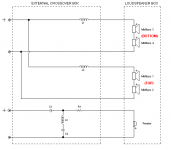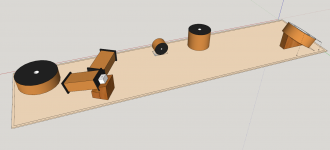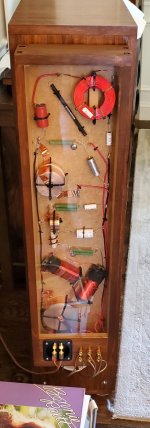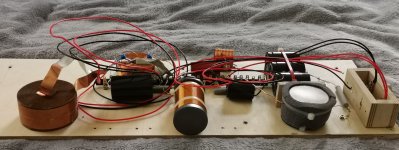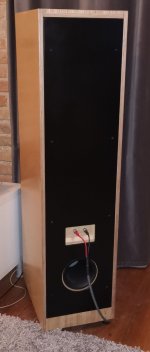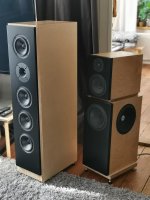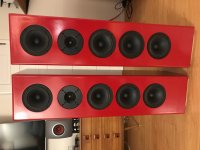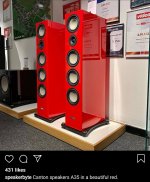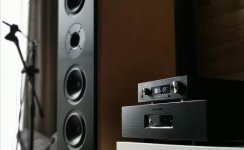Thanks Scott,
If I turn the little inductor isn't it going to be the same direction as the 20mH iron-core and that's the reason I turned the 4mH vertical?
In terms of resistance, yes, the resistance of the 20mH inductor plus the 6R8 resistor add up to 7.5Ohm as per Joe's recommendation.

..turning the little air-core toward the cap's and resistors.
Last edited:
How would there be a current induced in the metal if its non-magnetic?
I would not care about a piece of non-magnetic metal near the inductors.
Long answer:
Well, in actual facts, any electrical conductor (was it non-magnetic metal) placed into a changing magnetic field experiences flowing current loops.
An these loops in return create a magnetic field in opposite direction to the one having created the current in the first place.
Short answer: any electrical conductor into a magnetic field changes it.
That's not what you really want into a filter due to potential non-linearities.
Bi-amping?
I was looking over the crossover diagram and I never noticed this before, but it says "do not bi-amp". Which I had not noticed before. First of all, I wired the tweeter and upper mids to one bidding post and the lower mids to the other post. My amp is bridgeable, but I was having a problem with thermal protection and to narrow down the problem I decided to bi-amp instead of bridging those channels. I still have the problem, and I have been debating getting it fixed or trying to get it fixed, but it sounds fine bi-amped. The amp I have is a Parasound 806A which is a 6 channel amp, which I'm using for my front 3. I was thinking about continuing bi-amping the good channels to the Elsinores, and using the remainder good channel for my center, or even bi-amping it since the issue I'm having only happens when listening to music and I give it some real volume!
I looked over Joe's website and I didn't see anything that would answer this!
So why can't I bi-amp?
I was looking over the crossover diagram and I never noticed this before, but it says "do not bi-amp". Which I had not noticed before. First of all, I wired the tweeter and upper mids to one bidding post and the lower mids to the other post. My amp is bridgeable, but I was having a problem with thermal protection and to narrow down the problem I decided to bi-amp instead of bridging those channels. I still have the problem, and I have been debating getting it fixed or trying to get it fixed, but it sounds fine bi-amped. The amp I have is a Parasound 806A which is a 6 channel amp, which I'm using for my front 3. I was thinking about continuing bi-amping the good channels to the Elsinores, and using the remainder good channel for my center, or even bi-amping it since the issue I'm having only happens when listening to music and I give it some real volume!
I looked over Joe's website and I didn't see anything that would answer this!
So why can't I bi-amp?
The reason, if I recall the last time I looked a this was the distribution of the impedance conjugate circuits.
One option is to remove them altogether and bi-amp (like the e.g. below), another option is to sim or measure the impedances and recreate your own conjugates.
One option is to remove them altogether and bi-amp (like the e.g. below), another option is to sim or measure the impedances and recreate your own conjugates.
Attachments
..turning the little air-core toward the cap's and resistors.(..with that inductor still in its current "vertical" position.)
..wrong.
..air core should be flat on-board in its current position on-board.
I was looking over the crossover diagram and I never noticed this before, but it says "do not bi-amp". Which I had not noticed before...
The reason, if I recall the last time I looked a this was the distribution of the impedance conjugate circuits.
One option is to remove them altogether and bi-amp (like the e.g. below), another option is to sim or measure the impedances and recreate your own conjugates.
Allen has it essentially right.
Again a little theory. If you draw the same current at all frequencies, the amplifier's output impedance is largely cancelled out. Indeed you can use 'current drive' where the amplifier has an output impedance in the hundreds of Ohm, and the current phase angle is always zero. While I am not promoting 'current drive' it does have that positive. I do propose constant current and getting near zero degrees current phase angle that way. Now some may argue for or against that philosophy, be that as it may. But the design speaks for itself. These conjugates make a difference, but the difference may come down to the amp that you use.
For example (and I will not engage in lengthy debate here) is that 99.9% of all amplifiers designs are some form of Class AB, even most tube amps are. When these exhibit very low output impedances and thus behave like voltage sources, the transition from Class A to Class B is problematic if the current phase angle is not zero. This has been documented in the Netherlands by Hans van Maanen of Temporal Coherence. In dynamic driver, where it is the current through the voice coil that causes sound (and not current), yet the feedback used in voltage sources amps can only correct voltage and not current. Hans has pointed to the presence of high order distortions during that transition and recommends that the current of the amplifier should be equalised (current EQ) so that the current and voltage match each other in time. That means lower distortion!
This is of course lost if you bi-amp the Elsinores. But you can by-wire if you wish. But the amplifier must see the entire load or the EQ does not work.
Below link is an interesting read, but I want to delve further than he has:
Why Do Amplifiers Sound Different - Hans van Maanen
Cheers, Joe
Last edited:
My crossover layout
Not intending to sway opinion or change anyone's layout, but I laid out my inductors on a piece of cardboard matching the dimensions I decided to use for my cross over case. I followed someones amazing write up here about sending a tone through one coil and hooking up headphones or speaker to others and started moving things around so there was zero to almost no cross talk. Following another post in this great forum, lifted one on an angle and reduced the interference even more.
I also used zip ties to secure anything with weight and hot glue for components..
I cant find my drawing where I had the inductors labeled, but think this might help some one at some point...
Not intending to sway opinion or change anyone's layout, but I laid out my inductors on a piece of cardboard matching the dimensions I decided to use for my cross over case. I followed someones amazing write up here about sending a tone through one coil and hooking up headphones or speaker to others and started moving things around so there was zero to almost no cross talk. Following another post in this great forum, lifted one on an angle and reduced the interference even more.
I also used zip ties to secure anything with weight and hot glue for components..
I cant find my drawing where I had the inductors labeled, but think this might help some one at some point...
Attachments
I also decided to install a crossover on the back of the speaker. It gives a lot of freedom in placing the elements.
Looking at the solutions used by different designers, the positioning of the coils is more critical than their distance. This can be done in a smaller space. A little excess here. But if you go crazy it is on a grand scale
Looking at the solutions used by different designers, the positioning of the coils is more critical than their distance. This can be done in a smaller space. A little excess here. But if you go crazy it is on a grand scale
Attachments
JarBar,
Can you please also post a picture of your Elsinore speakers with the back panel attached?
To me it looks like AudioFanMan has placed his cross-over outside of the cabinet on a separate section fixed to the rear of the speaker, while you have placed the XO inside the cabinet with a removable back panel to cover it.
Can you please also post a picture of your Elsinore speakers with the back panel attached?
To me it looks like AudioFanMan has placed his cross-over outside of the cabinet on a separate section fixed to the rear of the speaker, while you have placed the XO inside the cabinet with a removable back panel to cover it.
Last edited:
tompa909,you did it exactly as I had planned when starting work on building the boxes. A similar form was already mentioned here on the forum. And it served as an inspiration for me. Only during the works did the whole thing change into its present appearance. I can see that this finishing quality also works great. Simple and elegant. Cool.
Attachments
tompa909,
Congratulations on you well executed build! Love the sporty red. We need some folks to shake it up from time to time with supercar colors, and thanks for putting your hand up and delivering the goods.
Enjoy the fruits of your hard work, and tell us more about how they sound to you as you gradually get more hours on them.
Congratulations on you well executed build! Love the sporty red. We need some folks to shake it up from time to time with supercar colors, and thanks for putting your hand up and delivering the goods.
Enjoy the fruits of your hard work, and tell us more about how they sound to you as you gradually get more hours on them.
tompa909,you did it exactly as I had planned when starting work on building the boxes. A similar form was already mentioned here on the forum. And it served as an inspiration for me. Only during the works did the whole thing change into its present appearance. I can see that this finishing quality also works great. Simple and elegant. Cool.
Funny, I actually saw the picture in your original post and must have been saved in my subconscious. Looks quite good with the all-black speakers. I had originally planned to do something closer to your final product, but rounded one too many corners on the front baffle and decided against it.
tompa909,
Congratulations on you well executed build! Love the sporty red. We need some folks to shake it up from time to time with supercar colors, and thanks for putting your hand up and delivering the goods.
Enjoy the fruits of your hard work, and tell us more about how they sound to you as you gradually get more hours on them.
Thanks. Yes, exotic red for sure! It goes perfectly with my red turntable.
Truth be told, no subwoofers for the LS50s. They are the version with built-in amps and have much better low-end response that the passive version. I built a couple of massive subwoofers a while back and didn't feel that they added that much to my enjoyment so I sold them. For what it's worth, the LS50s worked amazing in my room and were spectacular for both music and movies.
I haven't had a huge amount of time with the Elsinores but thus far they blow the LS50s out of the water in every way, except for the size.
I haven't had a huge amount of time with the Elsinores but thus far they blow the LS50s out of the water in every way, except for the size.

Thank you szczery. Elsionre are great speakers. Don't hesitate. Let me know during the construction process. They inspired me to look for a new amplifier. I think it's worth giving them a good power partner.
I will quote myself perversely. As I said, I did so. Elsinore got a new amplifier. It is Kinki Studio EX-M7. A powerful power plant. It is not a cheap device. But what's coming out of the speakers now lets you forget about costs. Outstanding bass quality and overall sound. Dynamics, timbre. There is something in this loudspeaker design that they also sound great with my old amplifier from 1998, made by the Polish manufacturer Sound Project. But with this new stove, the hell froze
Okay. I'm already quitting. I go back to listening to music.
Attachments
Last edited:
- Home
- Loudspeakers
- Multi-Way
- The "Elsinore Project" Thread
